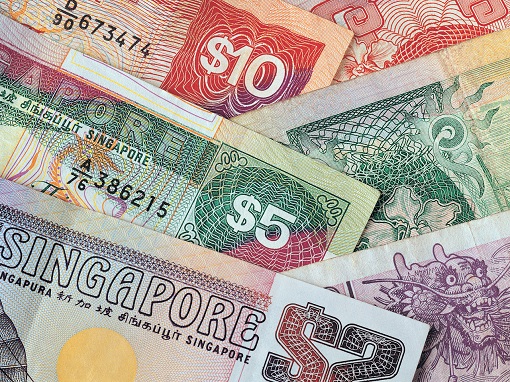 A Singapore national flag is seen near barricades as mourners wait for the funeral procession of Singapore's first elected prime minister Lee Kuan Yew outside City Hall in Singapore, on Sunday, March 29, 2015. Almost 415,000 people paid final respects to Lee Kuan Yew ahead of a state funeral today for Singapore's founding prime minister, which will draw dignitaries from around the globe. Photographer: Nicky Loh/Bloomberg
A Singapore national flag is seen near barricades as mourners wait for the funeral procession of Singapore's first elected prime minister Lee Kuan Yew outside City Hall in Singapore, on Sunday, March 29, 2015. Almost 415,000 people paid final respects to Lee Kuan Yew ahead of a state funeral today for Singapore's founding prime minister, which will draw dignitaries from around the globe. Photographer: Nicky Loh/Bloomberg
Singapore has a piece of very bad news for not only its own people, but also the region, if not the world. The small island’s economy almost came to a standstill in the second quarter, thanks largely to the US-China trade war, which has gotten worse after China retaliated against Trump’s 10% new tariff on the remaining US$300 billion of Chinese goods yet to be taxed.
Cutting its forecast for economic growth this year, the Ministry of Trade and Industry (MTI) on Tuesday (August 13) slashed Singapore’s full-year growth at between 0% and 1%, from its previous estimate of 1.5% to 2.5%. Essentially, this will be the slowest growth in the 10 years since the Great Recession exploded in the period between December 2007 and June 2009.
The final second-quarter data showed the country’s economy shrank 3.3%, a reversal from its 3.8% quarter-on-quarter growth in the first three months of the year. Reuters’ economists had estimated a 2.9% fall, while the Singapore’s own estimate was 3.4% decline. Anyways, it strengthens the bets that a recessionmay be around the corner. What it needed is another quarter of economic decline.

The Singapore Ministry of Trade and Industry said – “Looking ahead, GDP growth in many of Singapore’s key final demand markets in the second half of 2019 is expected to slow from, or remain similar to, that recorded in the first half.” However, the Monetary Authority of Singapore’s (MAS) chief economist Edward Robinson said its policy stance remained unchanged.
Still, the rapid deterioration in Singapore’s economic data has sparked speculation that MAS will ease monetary policy, a move that could weaken the Singapore dollar and help exports. The primary sector that hits the country’s economy is manufacturing, which shrank 3.1% in the second quarter from the previous year. Its retail trade sector also declined by 3.2% year-on-year.
So what’s the big deal even if it plunges into recession? It’s a big deal because even though Singapore may be one of the smallest countries in the world, the export hub is highly sensitive to external shocks and hence, is considered as a “barometer” of the global demand for goods and services. The nation is like the tsunami buoy system to detect incoming tsunami.

Because the city-state’s economy is highly dependent on trade, it has been one of the first places in Asia to be hit during global downturns. Likewise, it will be one of the first nations to recover during a booming economy. To illustrate, Singapore is the canary in the coal mine, where miners would bring caged canaries underground with them as the birds would die in the presence of even a small amount of poisonous gas.
Back in June, the writing was already on the wall when the country’s exports collapsed 17.3% from a year earlier – the fastest decline in more than 6 years, led by a fall in shipments of computer chips. Singapore is strategically a transit point for products heading to and from Western markets as well as the Asian base for manufacturers of some hi-tech goods.
India’s exports have plunged 9.7% in June while Indonesia, arguably Southeast Asia’s biggest economy, saw its exports dropped 8.9% in the same month. A month earlier, South Korea’s exports tumbled 10.7%. In June, Malaysia’s total trade contracted 6%, while its exports slipped by 3.1% compared with the same month a year ago.

Now that it’s almost certain that a US-China trade deal is out of the picture, the ripple effect of Singapore’s struggling economy would spread across the region. As China flexes its muscle, its central bank sets the official midpoint reference rate for the Yuan at 7.0326 per dollar on Tuesday – the fourth consecutive session where the currency was fixed at a level weaker than the psychologically important 7-yuan-per-dollar mark.
China’s move of devaluing its currency has been slapped with “currency manipulator” label by the United States. President Donald Trump has since announced that the U.S. isn’t going to do business with Chinese tech giant Huawei. Further depreciation of the Yuan or Renminbi is absolutely possible as it would depend on Trump’s next moves to counter Beijing’s strikes.
The interest rates cut by India, Thailand and New Zealand last week provide the necessary signals that the outlook for economic growth will only get worse. In his National Day message last week, Prime Minister Lee Hsien Loong noted that even as Singapore is experiencing an economic slowdown, the republic is ready to stimulate its economy with its deep pocket – US$263 billion as of May 2019.

– Finance Twitter


No comments:
Post a Comment
Note: Only a member of this blog may post a comment.